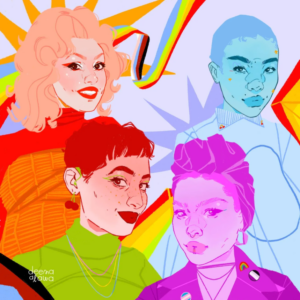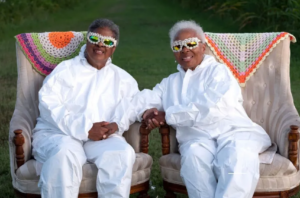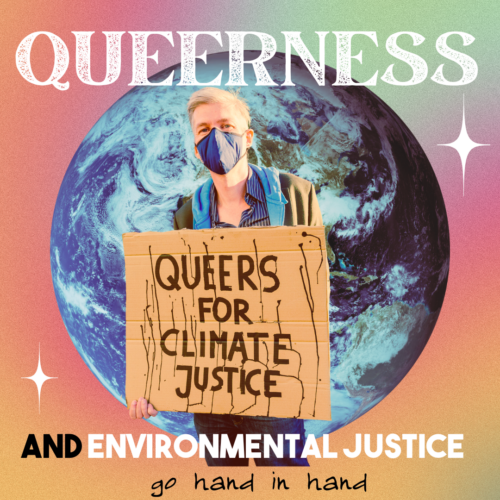Green Stripes

Illustration by Deema Alawa/ YES! Magazine
At the First National People of Color Environmental Leadership Summit in 1991, leaders across the environmental justice movement, including from here at WE ACT for Environmental Justice, developed 17 Principles of Environmental Justice. These principles have served as a guide for environmental justice work ever since. Principle #2 demands “that public policy be based on mutual respect and justice for all peoples, free from any form of discrimination or bias.” In the environmental justice movement, we usually understand this to mean across race and class, but it can also be applied to the idea that we must stand in solidarity towards justice across the intersections of identity, including LGBTQIA2S+ folks. As we celebrate the end of Pride 2024, we must look at environmental justice through multiple lenses, including a queer lens. All people of every gender and sexuality deserve safe, inclusive, and healthy environments.
Queer folks, particularly queer folks of color, have long been at the forefront of activist movements throughout the country. This ranges from civil rights organizer Bayard Rustin to writer James Baldwin, with many modern protest movements taking inspiration from the organizing strategies of the ACT UP movement. Queer communities of color, in particular, face increased threats due to intersecting oppression and discrimination based on race, ethnicity, class, ability, gender, sexual orientation, and other forms of systemic prejudice, which cannot be addressed in isolation. For example, LGBTQIA2S+ people of color may experience environmental injustices related to race and ethnicity, as would their cisgender and heterosexual counterparts, in addition to the disproportionate challenges, injustices, and harms the LGBTQIA2S+ population. Our understanding of these injustices, alongside our solutions and organizing must be intersectional, too.
On the pride flag, yellow signifies the sun, and green signifies nature, showing the importance of the environment to queer communities. Indeed, the liberation of queer people is tied to environmental justice. As more and more parts of the country legalize discrimination against queer communities, it’s time to broaden our understanding of what a safe and healthy environment means for LGBTQIA2S+ people.
Poverty and Housing
Due to systemic oppression and lack of adequate protections for queer and trans individuals in the workplace, in housing, and in healthcare, according to the National Network for Youth, LGBTQIA2S+ individuals are up to 120 percent more likely to be without stable housing. LGBTQIA2S+ youth in particular are more than four times as likely to experience homelessness than the U.S population at large. Queer people likely also experience indoor air pollution because of the high rates of indoor environmental hazards in housing shelters, such as lead paint and pipes, asbestos, and other pollutants.
Unhoused populations in major cities are always the first to suffer in extreme climate and weather events. Additionally, emergency centers are rarely equipped to adequately provide a safe and comfortable space for queer people, who often face difficulties accessing aid and other resources due to discrimination and a lack of government recognition. During natural disasters, LGBTQIA2S+ individuals of color face unique discriminatory practices, such as the two Black transgender women who were arrested for using the bathroom of their gender at an emergency temporary shelter during Hurricane Katrina.
“The people who are going to be most impacted by climate change are our people. They’re queer Brown people. They’re Brown people. They’re queer people. They’re poor people. And when you look statistically at who experiences poverty in this country, in the LGBTQIA2S+ community, it’s trans people. Our trans brothers and sisters are going to be the ones excluded from emergency disaster relief. They’re the ones who are going to face violence. So asking questions like, ‘How is climate change going to hurt our communities specifically?’ has become so important,” – Lindi von Mutius, a board member at Out4Sustainability, said in an interview with Earthjustice.
Health and Medical Care
Much like social determinants of health have been shown to be associated with inequitable environmental exposure based on race and socioeconomic status, chronic diseases associated with environmental exposure — respiratory diseases, cardiovascular diseases, and cancer, for example — are found at a higher rate in the LGBTQIA2S+ community than in cisgender, heterosexual populations, according to a study in the American Journal of Public Health.
Studies have found that areas with higher proportions of same-sex couples saw increased amounts of hazardous air pollutants compared with areas with lower proportions of same-sex couples. This has resulted in LGBTQIA2S+ people suffering higher rates of chronic diseases associated with environmental exposure, such as respiratory diseases, cardiovascular disease, and cancer. Half of Black gay and bisexual men have HIV, and Black transgender women are also particularly affected. Air pollution can cause and worsen conditions such as pneumonia and tuberculosis (TB) in HIV-positive individuals. For example, exposure to particles found in dust, such as from construction sites, smoke from waste burning, or nitrogen dioxide from car fumes, has been associated with an increased risk of pneumonia hospitalization in people with HIV. Given their compromised immunity, people with HIV are particularly distressed by poor air and water quality, and during environmental disasters can suffer disproportionately from lack of lifesaving medications and lack of access to health centers.
Additionally, queer communities face greater exposure to toxics from unsafe beauty products. Hair straighteners, skin lighteners, and makeup products can be packed with harmful chemicals that can leave negative impacts on the body. Many of these toxic products are disproportionately aimed at women and femme identified people of color. WE ACT hosted a panel on the topic of Beauty Justice for Pride Month in 2021, which featured a panel of researchers, advocates, and queer drag performers discussing the toxic chemicals found in beauty and other personal care products and their impact on the queer community.
Dr. Ami Zota, an Associate Professor in the Department of Environmental & Occupational Health at the George Washington University Milken School of Public Health shared,
“…no one is looking at how these issues are playing out in the non-binary and trans community and it’s partly because we don’t have that diversity in the scientific community […] It’s about helping these emerging leaders, all of whom are from historically excluded backgrounds […] cultivate their voice and ideas to center queer voices and giving them the platform to do that, and helping them rise with that authentic voice. We don’t want diversity just to have a brown body around in a board. We want that person to bring their own unique voice and ideas. That’s what we mean by inclusion and equity.”
However, while LGBTQ+ communities are facing health problems as a result of environmental injustices, they also face barriers in accessing medical care, further exacerbating these harms. A 2022 Center for American Progress study revealed that more than 1 in 3 LGBTQIA2S+ adults reported postponing or avoiding medical care in the past year due to cost issues. This includes more than half of transgender or nonbinary respondents, and more than 1 in 5 LGBTQIA2S+ adults reporting postponing or avoiding medical care in the past year due to disrespect or discrimination by providers, including more than 1 in 3 transgender or nonbinary individuals. This increases the likelihood that LGBTQIA2S+ people receive little to no treatment for health conditions caused by environmental pollution and climate crisis stressors.
When fighting for healthy homes and environmental health within the environmental justice movement, we must understand the unique and intersectional challenges that LGBTQIA2S+ communities face in health and medical care.
The Nature of Queer Joy

(Ælfleda Clackson for The Washington Post)
Even though the challenges that queer people face are real, queer joy and queer ecology are crucial to the environmental movement. Nature is queer – from penguins to bottlenose dolphins. Thankfully, concepts like queer ecology have been given greater recognition recently, an idea which emphasizes an environmentalism beyond binaries and allows for expansive potentials for understanding how humans interact with nature. This emerging field is helping to broaden our understanding of queer humanity in nature and our space within the natural world.
As an example, Queer Nature is a project characterized by nature-based education and critical naturalist studies. They design and facilitate nature-based workshops and occasionally multi-day immersions mainly for queer people of color, to create spaces of belonging in nature for folks who have often been made to feel that they biologically, socially, or culturally don’t belong. Queer Nature also supports scientific movements and projects that center community involvement, local and Indigenous expertise, and that acknowledge the social and political realities of knowledge production.
Liberation Movements Need Queer Leaders
The roots of the climate crisis are tied to the roots of various oppressions such as colonialism, patriarchy, extractive capitalism, and white supremacy. Additionally, the impact of the climate crisis exacerbates these systemic challenges faced by trans and queer people worldwide. Because of this, queer liberation must be held up as a core concept of climate justice organizing. In the past 50 years, the LGBTQIA2S+ community has achieved countless wins for the community such as HIV research advancement, ending gender markers on public transit, and setting the legal basis for women against employment discrimination, to only name a few. The power, effectiveness, and community of LGBTQIA2S+ individuals is indispensable in the fight for environmental justice and liberation for all.
Queers organize and fight on the frontlines of movements that work to disassemble systems of oppression across the globe, including Palestinian Solidarity and Black Lives Matter. The BLM movement was founded by three Black women, Alicia Garza, Patrisse Cullors, and Opal Tometi, two of whom identify as queer because Black and Brown people, cis and trans, are dying at the hands of police. In 2019, Layleen Polanco, a trans Latine woman who was an active member of New York’s Ballroom community, died while in solitary confinement at Rikers Island jail.
This Pride, interconnected causes have united into one huge fight- the fight for liberation. To achieve safety and justice for the LGBTQIA2S+ community, environmental and climate justice must be realized. And for that, queer liberation must be integrated across all social movements for justice. Even 55 years after Stonewall, regressive politicians seek to erase the LGBTQIA2S+ community from public life. But queer people have never been invisible and don’t plan on vanishing now. We continue to show up.
Queer Activists Working for Environmental Justice
As the environmental justice movement expands to include more communities and their unique needs, several activists are already paving the way for queer environmental justice.

Isaias Hernandez, known online as Queer Brown Vegan, is an environmentalist, educator, and creative devoted to improving environmental literacy through content creation, storytelling, and public engagements. His independent media platform brings intersectional environmental education to all.

Pattie Gonia is a critically acclaimed drag queen, environmentalist, and advocate for inclusivity and diversity in the outdoors. To date, Pattie’s community is more than 1,000,000 people strong. Pattie is also the co-founder of the Outdoorist Oath, a non-profit that gets BIPOC, LGBTQIA2S+ and femmes into the outdoors through community and education. Recently, Pattie founded the Queer Outdoor and Environmental Job Board, a free tool queer individuals can use to get hired and therefore diversify the fields.
 Thómas Lopez Jr. is a proud Xicano with a heritage deeply rooted in the legacy of Chief Leonard Crowdog Sr. and the lineage of Water Woman Sharon Dominguez & Sundance Chief Thomas Lopez Sr. With a passionate dedication to social justice, Thomas has spearheaded initiatives such as the International Indigenous Youth Council (IIYC) in it’s the fight against the Dakota Access Pipeline, Wells Fargo, Chase Bank and other fossil fuel expansion. Transitioning from activism to advocacy, Thomas now channels their passion for change through the power of digital creation, humor, community engagement, and cultural expression. Leveraging their influential platforms, Land Back Baddie and INDIGiQUEER Creative Alliance, Thomas continues to inspire audiences, sparking transformative dialogues and driving impactful action.
Thómas Lopez Jr. is a proud Xicano with a heritage deeply rooted in the legacy of Chief Leonard Crowdog Sr. and the lineage of Water Woman Sharon Dominguez & Sundance Chief Thomas Lopez Sr. With a passionate dedication to social justice, Thomas has spearheaded initiatives such as the International Indigenous Youth Council (IIYC) in it’s the fight against the Dakota Access Pipeline, Wells Fargo, Chase Bank and other fossil fuel expansion. Transitioning from activism to advocacy, Thomas now channels their passion for change through the power of digital creation, humor, community engagement, and cultural expression. Leveraging their influential platforms, Land Back Baddie and INDIGiQUEER Creative Alliance, Thomas continues to inspire audiences, sparking transformative dialogues and driving impactful action.

The “Aunties” Donna Dear and Paulette Greene own Mt. Pleasant Acres Farms, 111 acres of row crops, fruits, vegetables, forests, and wetlands. Their farm is a showcase of forestry management, organic food production, and Black history, as it was a stop along the Underground Railroad. Their food forest is providing a habitat for insect pollinators, songbirds, and game birds. They are also proud to be facilitating the restoration of relationships between Black people and land. They see this as an essential step towards real Climate Justice.
There are also dozens of organizations doing incredible and intentional work on this issue. If you would like to take action alongside LGTQIA2S+-led environmental organizations, consider joining one of these groups. Here are a few worth exploring:
- Out for Sustainability: For more than a decade, O4S has brought LGTBQ+ voices to the center of the movement. The organization sponsors service projects, summits, and events in regions across North America. O4S initiatives include Plastic Free Pride and Qready.
- Queers x Climate:QXC supports LGBTQ+ activists working to solve the climate crisis. From communications work to litigation, QXC works to harness the ingenuity of LGBTQ+ activists for the climate movement.
- Our Climate Voices: At its core, the climate crisis is about the people it impacts. Our Climate Voices works to share the stories of those impacted by the climate crisis and those working to solve it, centering queer voices at the intersection of climate and LGBTQ activism.
- Queer Nature: Our environment must be accessible to all, but too often that’s not case for LGBTQ2+, and in particular queer and trans BIPOC individuals. Queer Nature aims to create space for these communities to experience the natural world and learn ecologically-based skillsets. Queer Nature keeps a particular focus on justice-centered learnings, nature education, and ancestral skills.
- Queer Eco Project: The Queer Eco projects sits at the “intersection of ecological justice and queer liberation,” and aims to build a movement of queer folks impacted by the climate crisis and environmental injustice, and queer climate and environmental activists. With projects including #Queers4ClimateJustice, the Queer Eco Project aims to support and center those at the heart of the crisis.
- The Venture Out Project: The LGBTQ+ community deserves safe access to enjoy the great outdoors – and the Venture Out Project is making that happen. With wilderness trips, workshops, and nature-focused events, Venture Out offers opportunities for LGBTQ+ individuals to connect with our natural environment and build community.
Source: Climate Reality Project
Take Action
The Queer Liberation March will be Sunday, June 29th, 2025 and seeks to honor and reclaim the spirit of the Stonewall Riots, centering and amplifying the voices and needs of marginalized LGBTQIA2S+ communities. As a community, we take to the streets to challenge systemic oppression, advocate for justice, and create a world where all queer and transgender individuals are free to live authentically and without fear.
